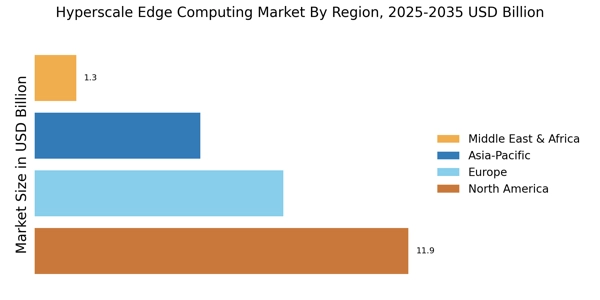The Hyperscale Edge Computing Market is characterized by a rapidly evolving competitive landscape, driven by the increasing demand for low-latency processing and real-time data analytics. Major players such as Amazon (US), Microsoft (US), and Google (US) are at the forefront, leveraging their extensive cloud infrastructures to enhance edge computing capabilities. These companies are strategically positioned to capitalize on the growing need for digital transformation across various sectors, including healthcare, manufacturing, and smart cities. Their operational focus on innovation, particularly in artificial intelligence and machine learning, is reshaping the competitive environment, as they seek to provide more efficient and scalable solutions to their clients.
Key business tactics employed by these companies include localizing manufacturing and optimizing supply chains to enhance service delivery and reduce latency. The market appears moderately fragmented, with a mix of established players and emerging startups vying for market share. The collective influence of these key players is significant, as they not only set industry standards but also drive technological advancements that shape the future of edge computing.
In September 2025, Amazon (US) announced the launch of its new edge computing service, designed to integrate seamlessly with its existing AWS infrastructure. This strategic move is likely to enhance its competitive edge by providing customers with more robust and flexible solutions tailored to specific industry needs. The introduction of this service underscores Amazon's commitment to maintaining its leadership position in the cloud computing space while addressing the growing demand for localized processing capabilities.
In August 2025, Microsoft (US) expanded its Azure Edge Zones, a service that allows businesses to deploy applications closer to their end-users. This expansion is indicative of Microsoft's strategy to enhance its edge computing offerings, thereby improving latency and performance for its clients. By investing in regional data centers and partnerships with telecommunications providers, Microsoft is positioning itself to capture a larger share of the market, particularly in sectors that require real-time data processing.
In July 2025, Google (US) unveiled its new edge AI platform, which aims to facilitate the deployment of machine learning models at the edge. This initiative reflects Google's focus on integrating artificial intelligence into its edge computing solutions, potentially providing clients with advanced analytics capabilities. The strategic importance of this move lies in its ability to attract businesses looking to leverage AI for enhanced decision-making processes, thereby solidifying Google's position in the competitive landscape.
As of October 2025, current trends in the Hyperscale Edge Computing Market include a strong emphasis on digitalization, sustainability, and the integration of artificial intelligence. Strategic alliances among key players are increasingly shaping the landscape, as companies collaborate to enhance their technological capabilities and market reach. Looking ahead, competitive differentiation is expected to evolve, with a shift from price-based competition to a focus on innovation, technology, and supply chain reliability. This transition may redefine how companies position themselves in the market, emphasizing the importance of delivering unique value propositions to clients.


















Leave a Comment